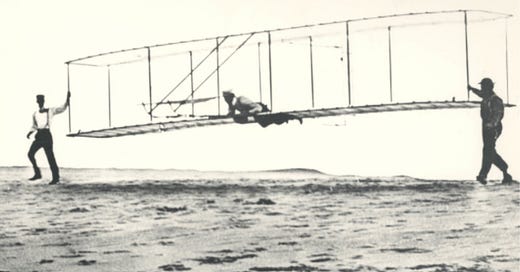The Century-Old Data Quality Blunder that Kept Humans from Flight
How the Wright Brothers found and fixed a fundamental data quality blunder, and finally conquered the skies ✈️
After over $1 billion invested, a series of disastrous experiments, and even one death, humankind had tried and failed to crack the secret to flight. So how did the Wright brothers, who weren’t even trained scientists, succeed where the most prominent scientific minds had failed for over a century?
The two brothers went against everything that the scientific establishment thought they knew and questioned a long-standing data point. After more than 50 tests in a wind tunnel, they realized there had been a major data quality blunder — every scientist had been using the wrong figure for air pressure. Without this realization, we would probably still be traveling by train today!
“In fact, the accurate wind tunnel data we developed was so important, it is doubtful if anyone would have ever developed a flyable wing without first developing this data.”
— Wilbur Wright
And, with that eureka moment, the first human “powered, controlled, and sustained flight” came to life.
Let’s dive in. Happy reading!
✨ Spotlight: How the Wright Brothers Conquered the Skies with Data
The Wright brothers set out to solve the “flying problem” for the world. They not only gave the world the “technology of flight” (as they called it) that we use today, but they also did what men and women had only dreamed about for centuries — they flew! What made it possible?
It turns out that working against gravity isn’t easy. In the 1800s, governments were losing billions of dollars and the leaders of the aviation industry were failing. The world leader in glider flight, Otto Lilienthal, even died when his glider plunged to the ground.
In 1899, the Wright brothers began investigating years of research data from reputed scientists and aviators such as Otto Lilienthal, Samuel Langley, and George Cayley.
Two years later, the Wright brothers began their first flight tests at Kitty Hawk — first unmanned and then piloted by Wilbur Wright. Their glider was designed based on their own experimentations combined with calculations from Otto Lilienthal (the first person to make a successful flight in a glider) and long-standing scientific equations for lift and drag.
This trial failed miserably, and the wings failed to produce the lift they needed. Disappointed, the brothers made their way home.
They later returned with larger wings, inspired by birds and again designed from Lilienthal’s data. This time, the results were even worse!
Disheartened, Wilbur Wright said, “Not within a thousand years would man ever fly.”
The Kitty Hawk failures brought the Wright brothers to the point of quitting. Everything seemed to work on paper, but nothing in practice. No matter what they did, their gliders only produced one-third the lift that calculations predicted. Their dream looked more elusive than ever...
The century-old data quality blunder 🤯
The Wright brothers’ gliders had been meticulously designed from years of first-hand experimentation and learning. So where were they going wrong? They questioned the only things they had used from others’ work — scientific equations for lift and drag.
The Wright brothers created their own wind tunnel to study how air interacts with metal wings. After more than four months and 50 tests, they realized why they weren’t getting the lift they expected — there was a major data quality problem.
The established Smeaton coefficient, which describes the density of air, was incorrect. And it wasn’t just a little wrong — it was off by 40%. This had trickled down and corrupted every lift formula for over 100 years!
Armed with the right data, the Wrights completely redesigned their glider. 18 months later, on 17 December 1903, man’s first “powered, controlled, and sustained flight” came to life. That first flight lasted just 12 seconds and covered 120 feet, but later that day, Wilbur flew for 59 seconds over a distance of 852 feet.

For the first time, a manned, heavier-than-air machine left the ground by its own power, moved forward under control without losing speed, and landed safely. And the world was never the same.
The Wright brothers had achieved what so many before them believed to be impossible and paved the way for the aviation industry we know today.
The brothers, who did not even finish high school, had made history. Was it because they were committed? So were the many talented scientists before them!
The Wright brothers are a timeless example of what the amazing humans of data can achieve. By questioning established data, they identified a major data quality error that had eluded the world’s smartest scientists for over a century and finally made the impossible a reality.
Read the complete story in this blog.
📚 More from my reading list
5 operational challenges in adopting data mesh architecture by Michael Ryan
Credit scores — why a data warehouse can never be a “single version of truth” by Steve Jones
[Twitter thread] Insights from building a “Developer Productivity Org” at Stripe by Rebecca Murphey
The powder keg of the modern data stack by Benn Stancil
The modern data platform design: a tool agnostic approach by René-Jean Corneille (special thanks for a great Atlan mention 💙)
I’ve also added some more resources to my data stack reading list. If you haven’t checked out the list yet, you can find and bookmark it here.
See you next week!
P.S. Liked reading this edition of the newsletter? I would love it if you could take a moment and share it with your friends on social.



